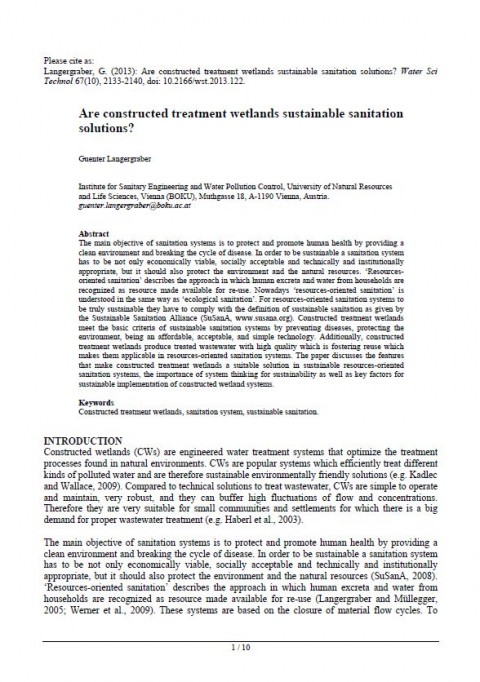
Published in: 2013
Publisher:
Water Sci Technol 67(10), 2133-2140, doi: 10.2166/wst.2013.122
Author:
Langergraber, G.
Uploaded by:
SuSanA secretariat
Partner profile:
common upload
5113 Views
152 Downloads
Content - Summary
The main objective of sanitation systems is to protect and promote human health by providing a clean environment and breaking the cycle of disease. In order to be sustainable a sanitation system has to be not only economically viable, socially acceptable and technically and institutionally appropriate, but it should also protect the environment and the natural resources. ‘Resourcesoriented sanitation’ describes the approach in which human excreta and water from households are recognized as resource made available for re-use. Nowadays ‘resources-oriented sanitation’ is understood in the same way as ‘ecological sanitation’. For resources-oriented sanitation systems to be truly sustainable they have to comply with the definition of sustainable sanitation as given by the Sustainable Sanitation Alliance (SuSanA, www.susana.org). Constructed treatment wetlands meet the basic criteria of sustainable sanitation systems by preventing diseases, protecting the environment, being an affordable, acceptable, and simple technology.
Additionally, constructed treatment wetlands produce treated wastewater with high quality which is fostering reuse which makes them applicable in resources-oriented sanitation systems. The paper discusses the features that make constructed treatment wetlands a suitable solution in sustainable resources-oriented sanitation systems, the importance of system thinking for sustainability as well as key factors for sustainable implementation of constructed wetland systems.
Additional information
Note: this is the unformatted version of the paper (after review and proof editing). According to Guenter Langergraber this is permissible under IWA copyright agreements to put this unformatted version online.
Bibliographic information
Langergraber, G. (2013). Are constructed treatment wetlands sustainable sanitation solutions?. Water Sci Technol 67(10), 2133-2140, doi: 10.2166/wst.2013.122
Filter tags
Constructed wetlands English















